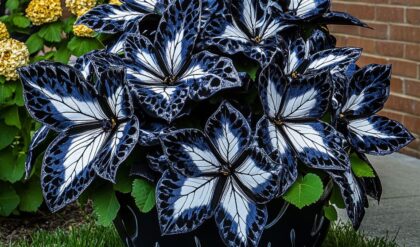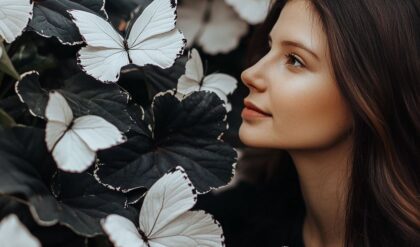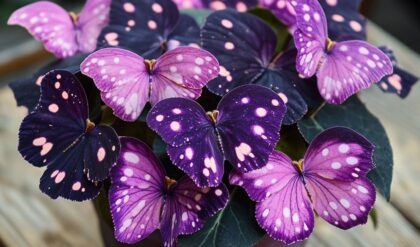Top tropical plants to grow indoors, what are they? Find out right here in our blog post, where to put them and detailed caring advice for beginners.
Ever dreamed of turning your place into a refreshing space with a little touch of green from tropical plants, but overwhelmed with hundreds of choices? Our editors have collected and picked out these 6 tropical plants to grow indoors, all of which are versatile and require low maintenance, totally a perfect match to your busy lifestyle.
In this blog post, we will also introduce you to each plant’s characteristics and how to take great care of them. No more worries being a beginner in this plant-biz.
Flamingo flowers (Anthurium)
Having a vivid and glossy look, the Anthurium originated from the rainforests of Central and South America. This plant is widely recognized for its bright red, heart-shaped spathes, and yellow tail-like spikes. With proper care, they can live about 5 years indoors, making the Anthurium one of the top tropical plants for beginners.

Where to place the Anthurium
- Tabletop: Carrying a bright and colorful appearance, the Anthurium brings a lively breeze to the house and attracts any eyes at first look into the place.
- Hanging basket: Even with limited space, Anthurium can be grown in a small hanging basket, adding vitality to the small room.
- Mixed containers: Anthurium is perfect to mix with ferns or orchids, creating a stunning display.
Advice for growing Anthurium
- Water regularly: As a typical tropical plant, Anthurium prefers a humid environment and moist soil. Make sure to water at least once a week
- Provide bright, indirect light: This kind of plant thrives in bright, filtered light, so a place near the window would be nice
- Use well-draining soil: Anthurium is easily rot-rooted, and you can add perlite or orchid bark to the potting mix for better drainage.
Bird of paradise
Native to South Africa, this plant features large, glossy leaves and spectacular flowers that resemble a bird’s head. Its flowers come in a variety of hues from sunset orange and purple to bright white. It can grow up to six feet tall and requires minimal care, making it a popular choice for indoor city houses.

Where to put Bird of Paradise
- Indoor focal point: Its bold foliage and unique flowers make it a perfect statement piece for any room.
- Outdoor garden: In an ever-warm climate, Bird of Paradise can be grown as a potted plant on the patio, or in the garden.
- Poolside: Having a tropical look, Bird of Paradise is widely chosen to put in pool areas.
Advice for growing Bird of Paradise
- Provide bright, indirect light: Direct sunlight might harm its foliage, so you better put it in a filtered-light area
- Keep soil constantly moist: Like any other tropical plant, Bird of Paradise prefers moist and well-draining soil. Remember to water regularly and avoid completely dried-out soil
- Fertilize: Use a balanced fertilizer every two weeks during the growing season to ensure healthy growth and flowering
Bougainvillea
Originating in South America, Bougainvillea is a stunning tropical plant that adds a burst of color to any space. It features vibrant, papery flowers in different shades like pink, purple, red, orange, and white. Bougainvillea can grow up to 30 feet tall and preferably chosen to decorate open spaces such as gardens, patios, and balconies.

Where to put Bougainvillea
- Walls and vertical plane: Bougainvillea can be trained to climb walls, trellises, and fences, adding a touch of tropical beauty to any outdoor space.
- Hanging basket: With a colorful bloom and cascading nature, this plant is perfect to hang outside the house, giving a stunning and impressive display.
- Container plant: In a cold climate, Bougainvillea can be grown in a pot and brought indoors during the winter months
Advice for growing Bougainvillea
- Provide full sun: To keep its vibrant bloom, Bougainvillea needs at least six hours under the full sun a day.
- Water sparingly: Bougainvillea is easily rot-rooted if excessively–watered, so make sure to use well-draining soil
- Prune regularly: Bougainvillea grows at a remarkable speed, which requires frequent pruning to maintain the desired shape and promote blooming
Bromeliads
Native to the tropical Americas, Bromeliads are one of few plants that grow in various settings, including soil, rocks, or even air. They come in a wide range of shapes and colors, making them to be popular choices for adding a touch of tropical look to the house, However, this plant requires a little more humidity and not so suitable for dry climates.

Where to put Bromeliads
- Tabletop: Having a colorful, vibrant look and unique foliage, Bromeliads make a lively addition to any tabletop or windowsill
- Vertical wall garden: Some Bromeliad varieties, like Tillandsia, can be mounted on a vertical wall, creating a living art
Advice for growing Bromeliads
- Provide bright, indirect light: Bromeliads prefer filter-light, but some varieties can tolerate low light conditions
- Water from the center: Known for growing in even extreme conditions, many Bromeliads feature a cup-like formation to collect as much water as possible. You should keep this cup filled with water and change it weekly to avoid bacteria growth.
- Sparing fertilization: Being a low-maintenance plant, Bromeliads only need to be fertilized with dilute liquid once a month during the growing season.
Croton
Native to Malaysia and the Pacific Islands, Crotons is typical for tropical plant species, with a colorful, vibrant look, adding a splash of color in any space. It features bold, shiny leaves in shades of red, orange, yellow, and green. Crotons can grow up to three feet tall and are relatively easy to care for, making them a perfect choice for indoor decorations.

Where to put Crotons
- Tabletop: With its colorful foliage, Crotons make an excellent tabletop accent and attract any eyes with a glance.
- Mixed containers: Low-maintenance and easy to care, Crotons can be combined with other tropical plants such as ferns or palms to create a stunning mix for outdoor spaces
- Outdoor hedge: In a warm climate, Crotons can be grown in a row, giving a unique hedge
Advice for growing Crotons
- Provide bright, indirect light: To maintain Crotons’ vibrant foliage, you should keep it under filtered light. Crotons can also tolerate direct sunlight, but excessive sun will cause leaf burn
- Constantly moist soil: As a typical tropical plant, Crotons prefer moist soil. Remember to water regularly and avoid dried-out soil
- Mist often: Crotons love high humidity, so make sure to mist them daily
Dracaena
Dracaena originates from Africa and Asia, features long, sword-like leaves, and appears in various colors like green, red, yellow, or variegated. This plant is widely known for its ability to thrive in low light and quite low maintenance, making it a popular choice for office, city house, and apartment decorations.

Where to put Dracaena
- Floor: Dracaena owns tall and striking foliage, bringing a perfect solution for empty corners or creating a focal point in any space
- Tabletop: Some kind of Dracaena with smaller leaves, like Lemon Limes or Warneckii, is used as table plants
- Privacy screen: Dracaena can also be grown in a row to create a lush and natural privacy screen
Advice for growing Dracaena
- Provide bright, indirect light: Yes, Dracaena might tolerate low light conditions, but you preferably grow it in filtered light to keep the vibrant look
- Sparing watering: As a drought-resistant plant, Dracaena does not require much watering, just once a week, and let it dry out slightly
Possessing unique textures and bringing a lively breeze into the space, tropical plants are a perfect way to decorate and give your house a total transformation. Whether you prefer bold flowers or striking foliage, these are the top tropical plants you might consider to add a touch of exotic beauty to your place.




